New York City Should Take Its Census Commitment to Communities of Color Into the Land Use Process
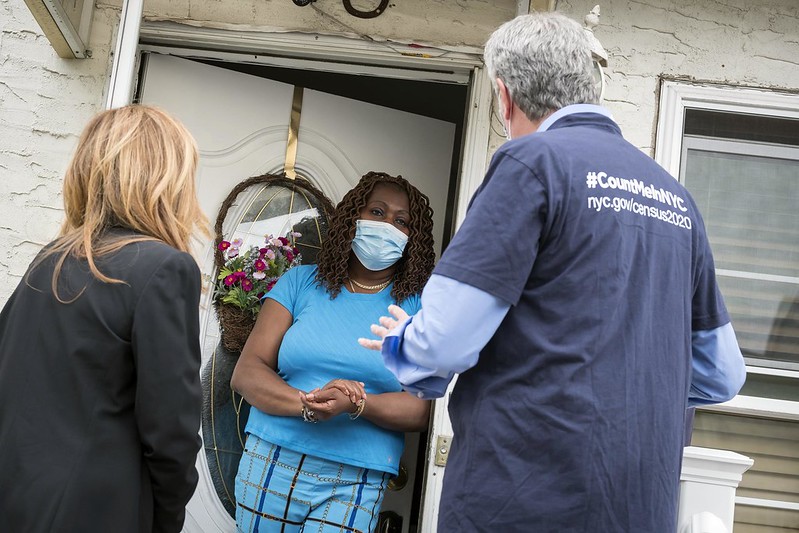
Mayor de Blasio doing Census work (photo: Ed Reed/Mayoral Photography Office)
When our communities are undercounted in the Census—as seems sure to happen in light of the recent Supreme Court decision—it costs us seats in Congress and money for local schools, health services, food assistance, highway construction, and many other services. When our communities are not counted in land use decisions, it costs people their housing, their small businesses, their social networks, and their culture.
With so much on the line, the City of New York developed a $40 million program to ensure a full Census count in New York City. A major component was the $19 million “NYC Complete Count Fund,” which allocated money to more than 150 community organizations to reach people across races, ethnicities, and over 80 languages. For the Census, the city made extraordinary efforts to reach into all minority and immigrant communities, knowing their residents are at highest risk of not being counted.
By contrast, for land use decisions the city ignores race and ethnicity, and assumes all residents, business owners, and employees are equally likely to be displaced or to benefit from a rezoning or other major land use action.
We commend the de Blasio administration’s critically important efforts to reach historically undercounted populations for the Census. Every New Yorker, regardless of citizenship, neighborhood, or culture should participate without fear or worse, apathy. With the Census, City Hall values our diverse communities in federal dollars. With land use, City Hall does not seem to value the authentic small businesses, arts districts, and unique cultures in our diverse communities—the enduring cultural legacies that make New York the city it is.
The opportunity presented by the city’s Census work provides a template for land use planning, and it’s time to follow it.
The city can create a more equitable and inclusive land use process by incorporating data, specifically about race and ethnicity. The current city process routinely ignores race and ethnicity by minimizing assessment of risks disproportionately concentrated with residents of color and minority-owned businesses. Yet many predominantly-minority neighborhoods that have been targeted for city-backed rezoning—the Bay Street Corridor on Staten Island, Jerome Avenue and Southern Boulevard in the Bronx, East New York and Bushwick in Brooklyn, and East Harlem in Manhattan—are areas in the bottom 20% of Census self-response rate nationally, and where the city makes special efforts to count people for the Census.
Given its intentional outreach for the Census, the mayoral administration should make a similar effort when it comes to land use changes, especially since the Census has been prematurely cut off, imperiling New York’s federal funding stream and making local resource allocations all the more consequential. And major land use decisions have impacts that extend far beyond the next decade.
A bill that has been proposed in the City Council, mandating the use of a Racial Impact Study in major land use actions, offers a step forward. This bill would require the city to consider the likelihood of disproportionate impacts across racial and ethnic groups of proposed land use changes. By requiring the city to break out impacts by race and ethnicity, the city could identify negative impacts on specific groups before they occur and thus take steps to avoid such harm while fostering development that equitably distributes benefits of land use changes, growth, and public and private investment.
Racial impact studies are entirely feasible, as other cities like Seattle and Minneapolis have demonstrated. Any argument that this is too cumbersome to require in the Environmental Review process ignores disparate impacts unmitigated development can cause. These neighborhoods need investments in critical resources like schools, libraries, and transportation options in ways that do not create displacement pressure.
The changes seen in Williamsburg-Greenpoint and Park Slope-Fourth Avenue in Brooklyn have been calculated on the back end. Retrospective analysis has shown the folly of omitting a critical racial lens from decision-making. In these neighborhoods, despite overall population increases in the years after the rezoning, thousands of Black and Latino families have been forced out.
We applaud the city’s substantial Census effort to ensure that every New Yorker counts. But now that the door has been slammed in our face by Trump and the Supreme Court, we have to make sure another door opens. Help us pressure the City Council to pass the requirement of a Racial Impact Study.
When we are all taken into account, our communities win.
***
Alex Fennell is Racial Impact Study Coalition Coordinator. Maxwell Cabello is an urban planner and housing policy analyst. Paul Epstein is Co-chair Inwood Legal Action. Robert Jackson is the New York State Senator for District 31 in Manhattan.
***
Have an op-ed idea or submission for Gotham Gazette? Email This email address is being protected from spambots. You need JavaScript enabled to view it.
New York City's Arab Community Deserves Full Democracy
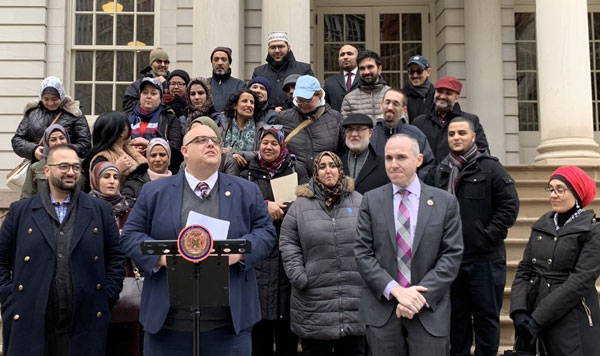
Council Member Justin Brannan, the author, with constituents and allies
As the City Council Member representing the 43rd District in Brooklyn, I represent the largest Arab community in the City of New York. This community has weaved itself into the complex fabric of my district, especially in Bay Ridge, where our avenues are lined with Arab-owned businesses, and several non-profit organizations that have been serving Arab-Americans and Arab immigrants for decades. I am proud to serve this community, and proud that its members are a part of what makes our district so unique.
Which is why every time Election Day rolls around, when I start to get calls from constituents complaining that there is once again no Arabic translation available at poll sites, I am totally distressed. Despite major efforts by groups attempting to turn out the Arab vote in recent years, voters continue to show up at the polls hoping for assistance, only to be turned away. Not only are translators not provided, but if campaigns or other organizations try to bring in their own to assist a voter, they are summarily denied access to the polls. It is clear the Arab community wants to vote and wants to participate, but its members are not given the assistance they need to fully do so.
The problem: in order to ensure ongoing translation services in a particular language, a community has to reach a threshold percentage of residents who speak that language, and the state Board of Elections will then consider adding that language to the ballot. Unfortunately for my district, this data comes from the Census, which presents a unique challenge for the Arab community, because “Arab” is not an option on the Census – Arabs are told to check “white.” This has led, as I have written in the past, to countless issues of under-representation and underfunding for our neighborhood – it simply looks like a large community of color does not live here when, empirically, anyone who spends more than five minutes in my district knows that is not the case. And the fact that this year’s Census looks like it will lead to a drastic undercount does not bode any better for the next decade.
In absence of state-level action on this issue, I introduced legislation in 2018 in the hopes that the City would provide the funding and staffing for supplementary translation services at the polls – as they do with several other languages that haven’t met the state thresholds, like Russian, Polish, and Yiddish. While City Hall has shown little interest in making this happen, the new city Civic Engagement Commission has finally made some progress -- it will pilot a new program this election cycle, which will provide Arabic translation separate from the Board of Elections at four poll sites, including the last two days of early voting (October 31 and November 1).
This is great news for our district, but it is not a permanent solution. We need reliable, regular language translation for Arabic speakers at our poll sites.
Translation at the polls is not a luxury or a privilege. Every citizen has a right to vote, and it is a right that new Americans deeply treasure. New Americans go through months of study, English classes, paperwork and appointments, and expensive filing fees to be able to become citizens – so when the time comes to vote, can you blame them that they want to participate and do it correctly? Specifically, so many of my constituents come from countries whose implementation of democracy is unreliable at best. They want to vote the way they wish, they want to vote correctly, and they want their vote to be valid and secure.
I often hear criticism that we shouldn’t need translation at the polls, because anyone who is a citizen passed an English test, and at this I cannot help but laugh. Ballots in recent years have been multiple pages long, they’ve included information on city- and state-wide referendums that are described in multiple paragraphs in barely readable fonts, they’ve included ballots that instruct you to choose multiple judges, or multiple presidential delegates – three candidates in one column, one in another. It is enough to confuse many native English speakers and lead to many invalidated ballots! Yet, all of these are choices that any citizen who pays taxes and participates in this community deserves to weigh in on, and they should not be prevented from doing so because of their level of English reading comprehension.
When we do not assure a community that voting will be easy, safe, secure, and valid, a community will not show up in its full capacity. And that’s the case with ALL communities. When voters hear about long lines at poll sites, invalidated ballots, broken machines – they don’t show up. Language access is no different. By refusing to have Arabic translation at the polls, we are telling the Arab community – a community that has fought so hard for representation – that its votes do not matter. We simply cannot do that in our modern democracy. Not for any community, but certainly not for one with so much on the line.
The Arab community has a lot at stake in this election. Its members’ home countries are in the midst of political upheavals, viruses, economic upswings and downturns. In the U.S., federally, they face the prospect of restrictions to immigration reform, travel bans, and a rise in Islamophobia. And locally, these are families who want to have a say in who represents them in elected office, their schools, their public transportation systems, their housing. It is unjust that the Arab community is so often the subject of headlines, but its members are being denied an opportunity to control their futures.
While I’m glad that Arabic translation will be provided at a few poll sites this year thanks to the efforts of the Civic Engagement Commission, it is crucial that we get this pilot right, and that we come up with a permanent solution for all poll sites. It is the right thing to do at any time, but particularly when so much is at stake.
***
Justin Brannan is a member of the City Council representing parts of Brooklyn. On Twitter @JustinBrannan.
***
Have an op-ed idea or submission for Gotham Gazette? Email This email address is being protected from spambots. You need JavaScript enabled to view it.
Time for the Big Banks to Reinvest in New York City

Eric Adams at a Brooklyn business (photo: @BKBoroHall)
At the height of the pandemic New York City did the unthinkable in the city that never sleeps: it closed up shop. To stop the spread and protect lives, we shut down everything—including the tens of thousands of small businesses that are the backbone of our local economy.
The sacrifice was immense. New Yorkers gave up their livelihoods and put their American dreams on hold. Some lost everything.
It did not have to be this way. One good thing that Washington did during the crisis was to fund a lifeline for small businesses. Hundreds of billions of dollars of federal relief was applied in the form of the Payroll Protection Program (PPP). But far too little of that money ended up in the hands of small business owners in New York.
Why? Bias and greed. The big banks that were the main conduit for the funds did not have preexisting relationships with small businesses that needed help, especially those owned by people of color. So those businesses were often either denied the loans or outright ignored. Even worse, while the biggest banks were excluding small businesses, they were funneling PPP money to huge corporations that already had lucrative relationships with the nation’s largest lenders.
It may go down as the largest rip-off in the history of the United States—and it happened in our backyard; most of these banks are headquartered in New York. While they were arranging for big restaurant chains and major retailers to get fat government checks from the top floor of their skyscrapers, locally-owned eateries and gift shops on the bottom floor were closing forever.
Mad yet? No? This should do it: not only were those banks taking money that New York’s small businesses desperately needed and doling it out to their friends at Fortune 500 companies, but they were simultaneously getting city tax breaks.
Citibank, for example, has received more than $100 million from New York City taxpayers over the past 30 years. What did we get in return? The bank cut its city workforce in half.
Then, after covid hit, news reports were everywhere that Citibank was relocating its remaining workers to the suburbs. At the same time, analyses of their PPP loans and that of other big banks shows they favored their very wealthy clients and corporate customers over small businesses.
As the center of global commerce, New York has helped build big banks, providing the talent and tax breaks they relied on to create immense wealth. In return, the financial sector has been an important source of jobs and tax revenue for our city.
In this time of crisis, those banks should provide significantly more new small business loans and capital to boost our recovery than they have committed to so far, and hold firm on the employment promises they made in the past. In this respect, JP Morgan deserves credit for moving forward with its new headquarters in Manhattan, and being vocal about getting its employees back to work in the city.
And Citibank has also now committed to buying $50 million in loans made under PPP by smaller lenders to city employers, and making another $1 billion in loans nationwide designed to close the racial wealth gap. But if past is precedent, we can’t just take them at their word. New York City government should instead take steps to ensure big banks better serve New Yorkers going forward.
First, let’s use our leverage as a major regulator and customer of big banks. The City’s Banking Commission -- which has a three-member board of the mayor, city comptroller, and commissioner of the Department of Finance -- has the power to determine which banks can operate here, hold city government’s billions of dollars in deposits, and handle our bond issues. Our comptroller also plays a key role in choosing which banks manage our pension funds.
That’s a lot of leverage to force big banks to do right by New Yorkers. We should use it. We should also use the city’s deposits to significantly expand the program to capitalize local lenders, referred to as CDFIs, who loan to our smaller employers and already have deep relationships with minority-owned businesses.
Finally, there are 360,000 households in New York that are unbanked and another 780,000 households that are underbanked, meaning they rely on sketchy services such as check cashing and payday loan parlors. The city should work with landlords and larger banks to offer discounted space -- which is unfortunately now much more available -- in lower-income communities to open branches to help those New Yorkers improve credit, access financial tools, and build savings and wealth. And those banks should hire locally for those branches.
What happened to New York’s small businesses during the covid crisis is a crime. If we don’t toughen up and show some teeth, nothing will improve. If we don’t stand up for our small businesses, who will?
***
Eric L. Adams is the Brooklyn Borough President. On Twitter @ericadamsfornyc.
***
Have an op-ed idea or submission for Gotham Gazette? Email This email address is being protected from spambots. You need JavaScript enabled to view it.
Two Essential Reforms to the Manhattan DA’s Office to Better Protect Victims
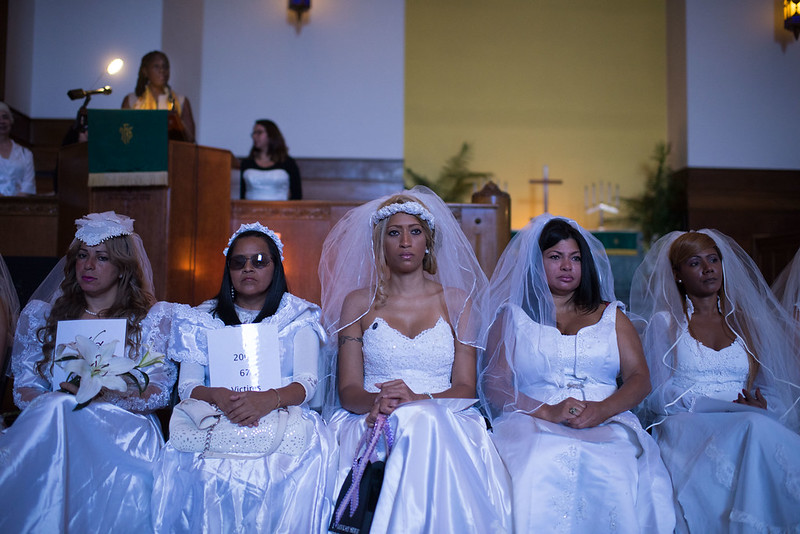
The 16th Annual Gladys Ricard and Victims of Domestic Violence Memorial Walk/Brides' March (photo: Michael Appleton/Mayor's Office)
The Manhattan District Attorney’s Office is in need of reform, but practicality and feasibility must be considered first and foremost when we look to implement changes that can realistically make a difference in its effectiveness in serving New Yorkers. Make no mistake though, internal and pragmatic changes can make those differences significant for many people who experience what are often traumatic instances of direct contact with our criminal justice system.
The debate over reform of our criminal justice system is a long overdo and important one, but in our ardent and compassionate efforts to see justice for those unfairly or arcanely prosecuted and detained, we seem to have forgotten the most important people in the criminal justice equation: victims.
Two major reforms that I am proposing in my campaign for Manhattan District Attorney are establishing a Sex Crimes and Domestic Violence Bureau at the office and strengthening its investigatory capacity, both of which will go far in ensuring the rights of victims do not become marginalized in the future.
Establishing a Sex Crimes and Domestic Violence Bureau
For too long, sex crime and domestic violence victims have suffered at the hands of their assailants in ways that persist psychologically well beyond the instances of the crimes committed against them. This is a result of the district attorney office neglecting to offer the full support and resources victims need and deserve.
Victims require additional resources because these crimes are often especially complicated and cannot be treated like normal street crimes. A Sex Crimes and Domestic Violence Bureau will be staffed with assistant district attorneys and social workers who work exclusively on sex crimes and domestic violence cases.
The first step is to educate victims on what their rights are, how the legal system works, as well as the ins and outs of what occurs during the pendency of a criminal case. This information is sometimes lost in the procedural shuffle and not fully understood.
The next step is to engage head-on the overwhelming consequences that can haunt victims of these crimes, which can often spur emotional, psychological, and physical ramifications. For victims, there are logistical problems of how to maintain housing, the education of their children, and medical care (to name a few) that need attention as well. With a centralized bureau, we will better handle the criminal matter, while at the same time helping the victim begin to regain a sense of normalcy.
The bureau will allow staff investigators and social workers to address the special needs of sex crime and domestic abuse victims and provide support, which includes counseling, support groups, physical protection, and more. This will provide them the social and mental resources necessary to overcome their traumatic and often unique situations.
The bureau will also look at mediation and restorative justice to help assist victims in obtaining closure on their road to recovery. This goes beyond just educating victims on how the system works. It also includes listening to their feelings on what justice means to them in each case.
Additionally, we will staff the newly formed bureau with the right number of social workers to work with victims who feel intimidated or traumatized as potential witnesses or providers of essential evidence in a criminal trial.
Providing these resources will not only help known victims, but further institute a culture that will encourage other victims to come forward without fear of retribution or lack of protection or services. This will comprehensively restore confidence in the justice system so that victims feel supported enough to come forward and allow prosecutors to investigate crimes and bring about justice.
Strengthening the Office’s Investigatory Capacity
As a former team member of District Attorney Robert Morgenthau’s Investigation Division, I worked for two years on complex white-collar cases locally, nationally, and internationally.
New Yorkers are often dismayed by the recurring sensationalization of street crimes through outrageous headlines and fear-mongering in newspapers and on television. While these crimes are unquestionably serious, the inordinate amount of attention we pay them works to downplay in our collective consciousness the often far-reaching and detrimental effects of white-collar crime.
Wealth and power can often provide cover for crimes motivated by greed, while enabling ever more inventive criminal opportunities that skirt accountability. In such uncertain times, our city must be on the cutting edge of fighting white-collar crime, especially with the proliferation of cybercrime, hacking, identity theft, and the new crimes of the 21st century.
The Manhattan District Attorney’s Office has lost its focus on its investigatory capacity. We must mobilize its existing powers to pursue with teeth white-collar crimes that impact our economy and directly impact hardworking New Yorkers.
In the financial capital of the world we need to consider with more gravity malfeasance that not only hurts our financial institutions, but can cripple our economy and devastate hardworking taxpayers, leaving a lasting effect on communities and families. It is essential that we strictly prosecute perpetrators of everything from fraud, embezzlement, and bribery to illegal third party transfers and deed theft.
This requires establishing in the office a culture of fairness that begins with re-instituting its intake bureau, which once allowed everyday Manhattanites to bring their complaints directly to investigators. Unlike street crime, white-collar crime often does not reveal itself to us inherently, and the NYPD is not equipped to tackle the problem in any practical, legal or functional way.
When we prioritize and strengthen the investigatory capacity and powers of the office to uncover economic injustice, we ensure investigators utilize the full range of resources and tools provided to them and prosecutors are able to compile the necessary evidence required for the convictions they seek.
The District Attorney’s Office has the responsibility to prioritize all of the investigatory resources it has available to ensure our criminal justice system works for everyone, because white-collar crimes make victims of all of us.
***
Liz Crotty is a candidate for New York County (Manhattan) District Attorney. On Twitter @LizCrotty2021.
***
Have an op-ed idea or submission for Gotham Gazette? Email This email address is being protected from spambots. You need JavaScript enabled to view it.
Surveillance and the City: Online Bar Exam, Remote Learning Fuel In-Home Surveillance
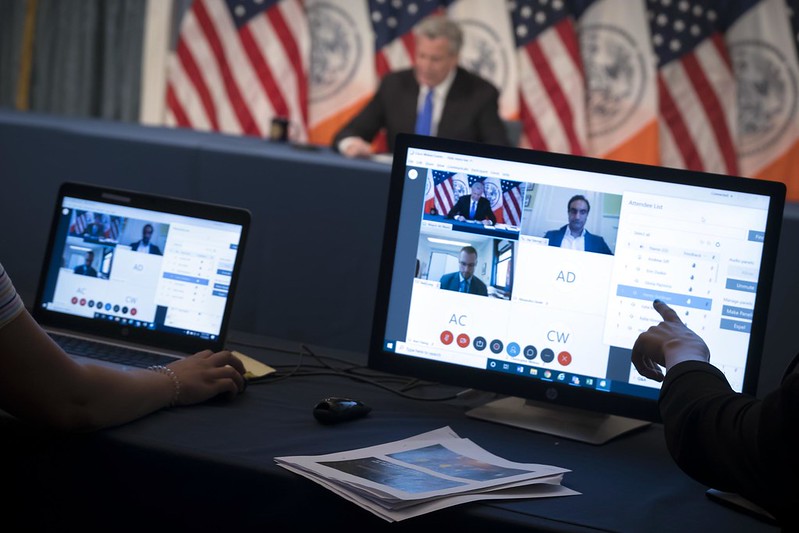
Inside the mayor's digital briefing (photo: Ed Reed/Mayoral Photography Office)
Standardized testing has never been fun for students, but in the age of COVID-19, it’s positively nightmarish. As the pandemic forces students and teachers around the globe to stay home, every part of education has suffered, but test administration has completely collapsed. Recently, despite public outcry, more than 10,000 law school graduates sat for the bar exam, putting their careers and livelihoods in the balance. The bar exam used software that was and remains shoddy, invasive, and likely biased.
Artificial intelligence (A.I.) testing was growing quickly in the United States even prior to COVID-19, and so were the errors. As of 2019, at least 21 states used natural language processing to grade student essays. The resulting marks certainly were artificial, but they were far from “intelligent.” Some students found themselves inexplicably moved from the honor roll to academic probation. Meanwhile, when other students realized that they were being judged by simplistic algorithms, they submitted strings of buzzword-laden nonsense and received perfect grades.
In contrast, colleges and universities mainly relied on A.I to hunt down plagiarism prior to the pandemic, hiring third-party student surveillance platforms to look for copied language. But in the first weeks of the shutdown, newly-online institutions invested heavily in student surveillance, including behavior tracking, restrictive software, and unproven forms of A.I.. As of April, a majority of colleges and universities used student surveillance services, with nearly a quarter planning on doing so in the future, according to a survey by Educase.
Many K-12 schools are now following suit. Human proctors are being replaced in some cases with spyware that tracks test-takers, their homes, and even their loved ones. In giving test officials unprecedented access to students’ lives—both their digital devices and their physical spaces—testing officials are making students pay for their degrees with their privacy.
Remote student surveillance broadly fits into three categories. First, spyware monitors a student’s computer, identifying any other applications in use. This spyware can include a log of every keystroke and mouse click a student makes, as well as looking at a student’s existing software. Second, many schools use a proprietary “lockdown browser” that provides heavily restricted internet access. Third, and most disturbing, some educators use a student’s own webcam to conduct persistent video and audio surveillance. These recordings not only capture intimate confines of a student’s home, but they are frequently reviewed by biased computer vision software for signs of cheating.
The trend is sadly not confined to educational programs. Aspiring attorneys in New York provided a terrifying test case and a cautionary tale on how this same technology can be misused as part of government licensing exams. The New York State Board of Law Examiners used a suite of products from ExamSoft, for its first online bar exam. First, students were forced to verify their identity using ExamID, a proprietary facial recognition tool. After, they had to run ExamMonitor, deeply invasive software that records test-takers through their own camera and microphone, purporting to use artificial intelligence to detect “suspicious behavior.”
The bar’s use of facial recognition is disturbing and must not be repeated. The technology is biased, error prone, and antithetical to the values that the legal profession claims to uphold. In some cases, employers have found that facial recognition simply would not recognize Black and transgender applicants. But facial recognition is not unique—every form of artificial intelligence is undermined by biases.
As seen with the United Kingdom’s A-levels fiasco, A.I. is shaped by countless human decisions, replicating and frequently augmenting the biases of the programmers who design the model and select its training data.
ExamSoft has released minimal information on its facial recognition and other artificial intelligence models, not even its accuracy and error rates. Examinees and members of the public have no way to evaluate the reliability of such a testing scheme or how it reflects on test-takers’ fitness to practice law.
Even without A.I., recording footage of examinees’ homes is deeply invasive, prying into their most intimate spheres of life. The risks are far from theoretical. For example, after the American Board of Surgery’s General Surgery Qualifying Exam, proctors reportedly contacted examinees after the exam on social media.
Additionally, ExamSoft’s privacy policy states that it may share data with law enforcement, transforming the bar exam into a warrantless wiretap of test-takers’ homes. It is disturbing and deeply ironic that a cohort of lawyers have been tested on the protections against government searches at the same moment they were forced to use software that eviscerates those rights.
The bar exam fiasco is a cautionary tale of what is to come. It is essential that future exams of this kind provide similar pathways such as the requested “diploma privilege,” instead of subjecting law school graduates to unwarranted, unethical, and unnecessary forms of surveillance. Such measures can mitigate fallouts from comparable testing calamities, but will be little comfort for the millions of other students still facing the threat of online testing and A.I. surveillance.
***
Albert Fox Cahn is the founder and executive director of the Surveillance Technology Oversight Project (S.T.O.P.) at the Urban Justice Center and a fellow at the Engelberg Center for Innovation Law & Policy at N.Y.U. School of Law. He writes the monthly Surveillance and the City column at Gotham Gazette and is on Twitter @FoxCahn.
Alice Beck holds master’s degrees in International Law and International Humanitarian Law and Human Rights.
***
Have an op-ed idea or submission for Gotham Gazette? Email This email address is being protected from spambots. You need JavaScript enabled to view it.
The NYPD is Undermining Our Ability to Hold Them Accountable. The Mayor Must Act
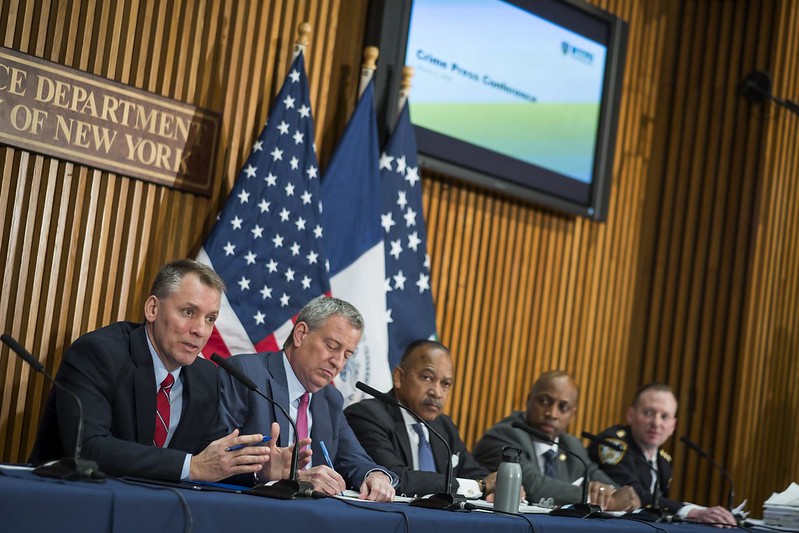
NYPD Commissioner Shea, Mayor de Blasio, other police officials (photo: Ed Reed/Mayor's Office)
As an international non-governmental organization, Human Rights Watch (HRW) reports on human rights abuses in every part of the world. Recently, its work brought it to New York City and more specifically, the Bronx. In a newly released report, HRW documented rampant police violence during a summer protest against police brutality, revealing that the NYPD’s actions violated international human rights law.
On June 4, after the city’s misguided and short-lived curfew went into effect, the New York City Police Department executed a planned assault on peaceful protestors. Using a tactic known as ‘kettling,’ officers trapped, rounded up, and arrested hundreds – with no warning. Among them: bystanders, medics, and legal observers.
The NYPD’s conduct that night – which included firing pepper spray and beating protestors with and without batons – resulted in the injuries of at least 61 people and violated international human rights law.
Equally as troubling was the NYPD’s targeting of legal observers, who are neutral, third-party spectators and do not partake in protest. First established in 1968, National Lawyers Guild Legal Observers have monitored New York City protests for decades with an important job: ensuring people are able to exercise their first amendment rights without interference from law enforcement.
While their presence at public demonstrations, rallies, and marches often serves as a deterrent to police violence, when that fails, legal observers record notes, photos, and videos to document police misconduct and potential civil rights violations. At times, these reports lay the groundwork for legal action.
The NYPD’s own Patrol Guide lays out protections for the work of legal observers: “individuals have a right to lawfully observe and/or record police activity including, but not limited to detentions, searches, arrests, or uses of force.”
The manual further states: “All members of the service will extend every courtesy and cooperation to observers. Observers shall be permitted to remain in any area, or observe any police activity, subject only to restrictions necessitated by personal safety factors, as determined by the incident commander.”
As essential workers, legal observers were exempt from the city’s curfew. My office reached out to Mayor de Blasio’s staff to confirm essential status for people providing jail, legal, and medical services to protestors. The mayor’s staff confirmed this on two separate occasions.
In addition to donning neon green hats clearly labeled “National Lawyers Guild Legal Observer,” LOs also carried documentation of exemption that night. They described an entirely peaceful protest until the NYPD got involved.
Yet, none of those things stopped the NYPD from crying “illegal counter-surveillance,” seizing privileged notes, using excessive force, and detaining at least 12 legal observers during the Mott Haven protest.
Not only did many officers fail to wear face masks, many also covered their badge numbers to prevent identification. Legal observers described being marshalled together and prevented from doing their job.
It is clear that the NYPD acted to prevent legal observers from bearing witness to police actions that night. This is in line with the attacks on legal observers happening across the country. During Black Lives Matter protests in Buffalo, Portland, Detroit, Cleveland, Sacramento, and Atlanta legal observers have reported being beaten, detained, and shot with rubber bullets.
Like a free press, legal observers are critical in ensuring our police department and government answer to the people. It should worry us immensely that the NYPD acted to undermine the watchdog role of legal observers. Open season on legal observers and journalists erodes our ability to hold the NYPD and other police departments accountable.
Despite the NYPD’s efforts to cover its tracks, as many as 100 lawsuits in an aggregate amount of hundreds of millions of dollars could be filed against the city. Forcing the burden onto the taxpayers, during a time of financial crisis no less, does not resemble anything close to accountability.
The very act of detaining legal observers demonstrates the brazen actions of a police department gone rogue. Unafraid of consequences and growing emboldened by the day, the NYPD does not expect to be disciplined.
This should come as little surprise considering the culture of impunity Mayor de Blasio and Police Commissioner Shea have enabled. While the appetite for police reform and calls to defund the police grow, the NYPD is working to strip New Yorkers of yet another tool for accountability.
Under the leadership of Mayor de Blasio, who has been deferential to Police Commissioner Shea, the NYPD has descended into lawlessness. Instead of having meaningful conversations about demilitarizing and divesting from the police department and investing in communities, we are once again at odds with a police department that routinely tramples on the rights of New Yorkers.
The Human Rights Watch report highlighted systemic and indisputable police abuse in the Bronx. Fortunately, it didn’t leave us empty-handed, suggesting various structural reforms like disciplinary action against the Police Commissioner, an NYPD hiring freeze, and budget transparency. Mr. Mayor, it’s not enough to condemn the NYPD’s attack on our constitutional rights that night – what are you going to do about it?
New Yorkers demand accountability.
***
Dan Quart represents parts of Manhattan's East Side in the New York State Assembly. He is a candidate for Manhattan District Attorney. On Twitter @AMDanQuart.
***
Have an op-ed idea or submission for Gotham Gazette? Email This email address is being protected from spambots. You need JavaScript enabled to view it.
This column has been corrected to note that up to 100 lawsuits could be filed, not have been filed as originally stated.
This is Chuck Schumer’s Moment; Why is He Blowing it?
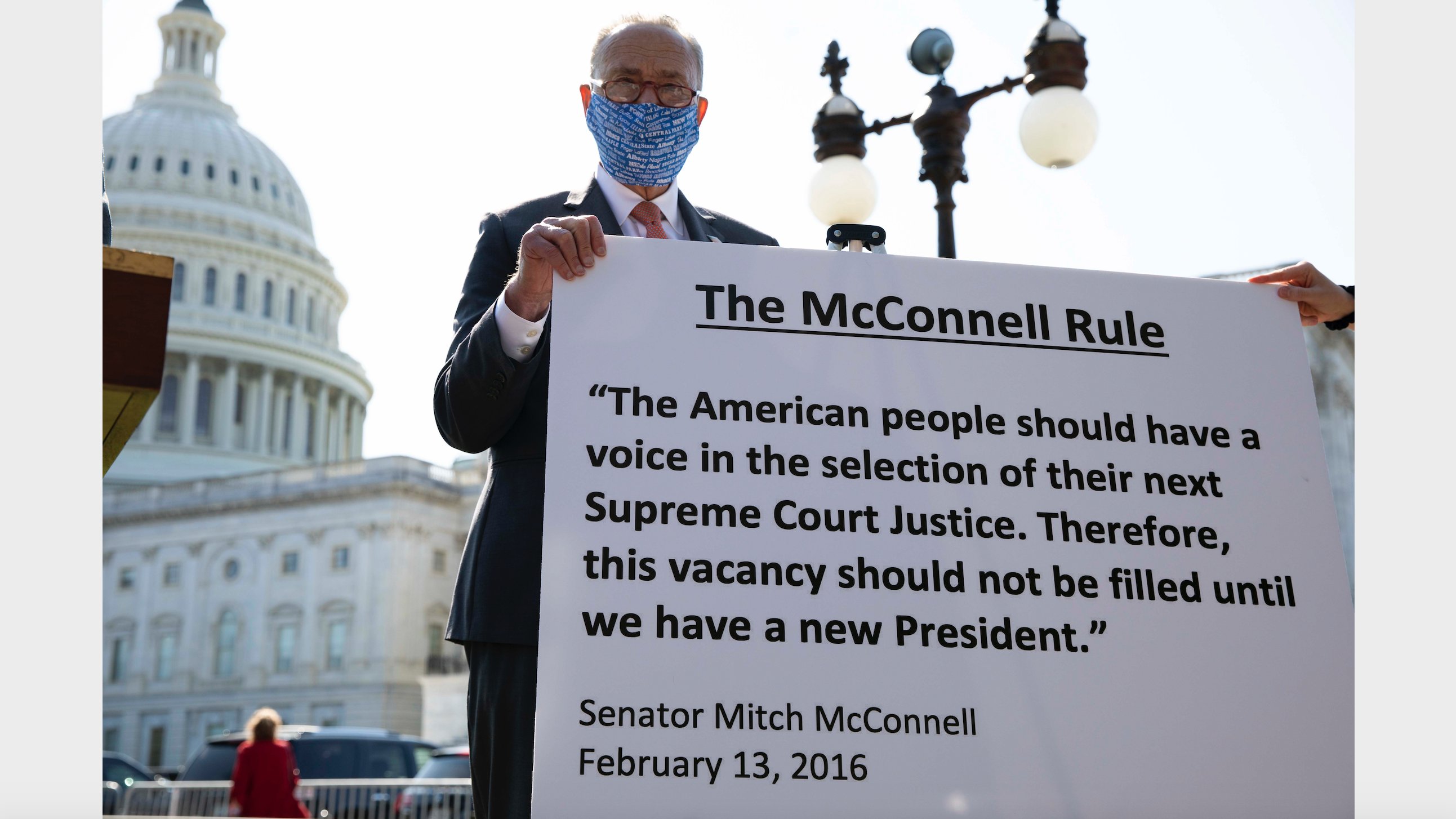
Senator Schumer calling out Senator McConnell (photo: @SenSchumer)
As New York-based activists, we’ve worked consistently to push Chuck Schumer to take a bolder stance against Trumpism, both as our senator and as the Senate minority leader. We’ve talked to him in person, we’ve protested at his house and his office, and we’ve flooded his phone lines. But we have never been so mystified by his lack of leadership as we have been during the Senate Judiciary Committee hearings for Supreme Court nominee Amy Coney Barrett.
Everything about Judge Barrett’s record and writings makes clear her radical right-wing ideology is a danger to all Americans. If confirmed, she will rule to strip health care away from millions of Americans during a pandemic, roll back Roe v. Wade, threaten the implementation of climate policy, and put corporations over workers and communities.
More importantly, the nomination process for Barrett is itself profoundly undemocratic and dangerous.
Voting in the 2020 elections is already happening and Senate Republicans are hypocritically pushing ahead after refusing President Obama’s 2016 nomination of Merrick Garland. With confirmed cases of COVID-19 in the Senate Judiciary committee, holding these hearings in person put lives at risk, including Senate staffers and building staff. Not to mention that Senate Republicans continue to obstruct covid relief.
With early voting underway in numerous states across the country and all polls pointing to majority support for Joe Biden, these hearings demonstrate Senate Republicans’ utter contempt for the will of the people -- just four years after Mitch McConnell obstructed the Garland nomination, made well ahead of the election.
And as the hearings unfolded, it was clear that the nominee herself has little regard for the law and instead intends to carry out a totalitarian agenda through the court. She refused to comment whether she supports a peaceful transfer of power; she refused to acknowledge that voter intimidation is a crime; and she refused to recuse herself from a case involving the Trump campaign if and when he challenges the results of the election.
This is a make or break moment for our democracy, and for all people.
So why does it seem like Schumer and Senate Democrats don’t understand that?
Democratic Senators including Dianne Feinstein, Patrick Leahy, Dick Durbin, Sheldon Whitehouse, Amy Klobuchar, and Chris Coons have met with Barrett, when they could have refused to do so. Senator Feinstein opened her questioning by asking irrelevant questions about Barrett’s children. Later, Feinstein inexplicably declared she was “impressed” with Barrett, handing Republicans a useful soundbite. And many Democratic Judiciary members participated in person in a hearing in which Republican Senator Mike Lee, who was recently diagnosed with COVID-19, refused to consistently wear a mask.
The whole process is wrong. The Senate should not be holding hearings three weeks before an election during a deadly pandemic. Senate Democrats should not be cooperating with Lindsey Graham or asking Barrett polite questions about her family, and they certainly shouldn’t be feeding the narrative that Barrett’s confirmation is inevitable.
As activists and organizers, we know that we don’t only fight for outcomes that are easy or guaranteed. It’s the hard battles, the ones that seem impossible, that need our ferocity even more.
Senator Schumer is the Democratic Senate Leader, it is his job to lead a caucus-wide messaging and procedural strategy to disrupt, delay, and discredit the hearings.
That’s not happening.
Instead, it has fallen to activists like us to write the memos detailing the tools available to him to delay the process, including denying a quorum and coordinating with House Democrats to introduce ‘must-pass’ legislation. It has also fallen to us to highlight the dangers of holding an in-person hearing; while Schumer tweeted about the danger of multiple confirmed and suspected cases covid among GOP senators on the Judiciary Committee, we were the ones who showed up in hazmat suits outside the Senate on Monday morning to emphasize the danger of COVID-19.
When Amy Coney Barrett refused to forcefully endorse a peaceful transfer of power, every Democrat could have stood up and walked out of the hearing. But they didn’t.
Polls show a majority of Americans don’t think the hearings should continue and say the seat should be filled by the next President.
On Wednesday, Judiciary Democrats muscled up and denied a quorum. That’s a start. But they need to go even farther. Senator Schumer and his colleagues should be bold and courageous in this fight and boycott the committee vote on Thursday -- as courageous as the activists who are protesting daily outside the Supreme Court and as bold as the majority of people who want the Senate to focus on covid relief instead of these sham hearings.
Senator Schumer should do his job. Or the people of New York will find someone who will.
***
Jaron Benjamin is an activist. Liat Olenick is a leader of Indivisible Nation BK. On Twitter @Jaronimoh & @Liat_RO.
***
Have an op-ed idea or submission for Gotham Gazette? Email This email address is being protected from spambots. You need JavaScript enabled to view it.
Throughout Shifting Education Experiences, New York is Failing Immigrant Families
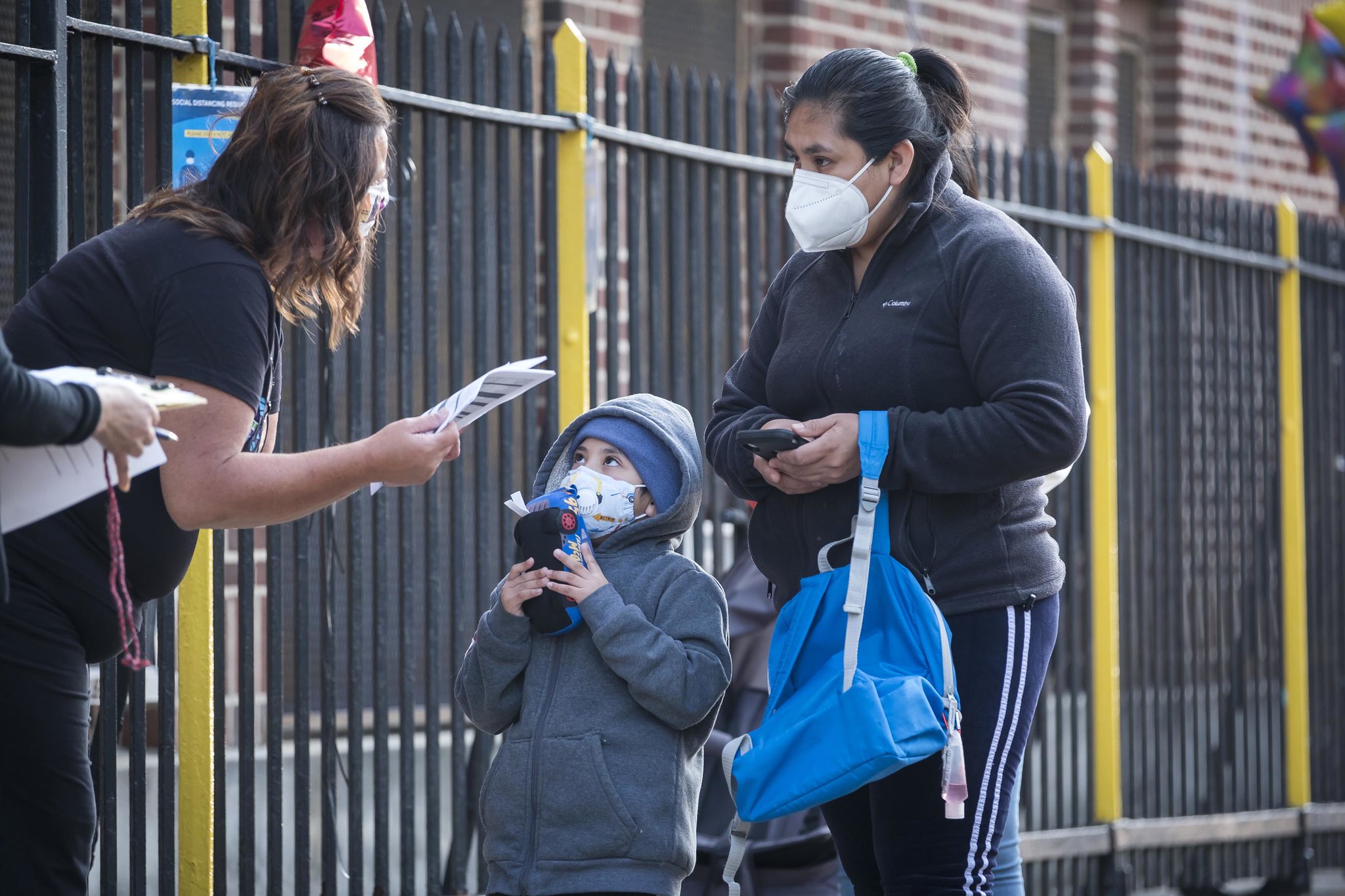
A student reporting to school (photo: Ed Reed/Mayoral Photography Office)
From English-only robo calls and critical emails to online-only surveys and a dearth of information in community media outlets, immigrant families have been left out of remote learning in New York, and they are confused and deeply concerned.
COVID-19 forced schools across the nation and in New York State to close in mid-March, quickly exacerbating pre-existing inequities in New York’s education system through the transition to remote learning. For New York’s immigrant students and their families in our public schools, the lack of clear and timely communication in families’ home languages prevented many from making informed decisions during a historic crisis and also shut many immigrant youth out of an education for months.
Approximately 38% of New York’s school-age children have at least one foreign-born parent, and youth learning to speak, read, and write in English (English Language Learners, or ELLs) account for nearly a quarter-million of the state’s students. When we fail to meet ELLs' needs, we fail their families and their communities, and we fail all New Yorkers.
It is especially important for schools to communicate effectively with immigrant families and actively support their engagement because survival is consuming a large portion of their bandwidth.
Immigrants tend to work in the industries hardest hit by the COVID-19 pandemic, live in the areas hardest hit by outbreaks, and make up a disproportionate number of those killed by the virus. In New York, nearly a quarter of residents are immigrants and they make up a third of the state’s front line workers, while numerous others have lost their employment due to the pandemic. These at-home crises impede ELLs’ academic success and create social and emotional trauma.
As school buildings closed and transitioned into remote learning, educators, advocates, and community leaders quickly rang the alarm that ELLs and children of Limited English Proficiency (LEP) parents were harder to reach and would require additional outreach and support to get integrated into virtual classrooms. Myriad obstacles for low-income immigrant families, such as lack of access to technology, housing, child care, and food, were exacerbated by the inconsistent and inappropriate means of communication employed by districts and schools across the state.
For years, the absence of timely, in-language communication has left many of New York’s ELLs behind. Under COVID-19 remote learning, these barriers have only intensified. Immigrant families fear that these problems will remain throughout the academic year that has just begun.
With Interim Commissioner Betty Rosa now at the helm, the New York State Education Department (NYSED) has a real opportunity to address the deficiencies of these past months and launch proactive strategies to reach and meaningfully engage our ELL and LEP families.
NYSED should require school districts to track and improve school engagement with immigrant students and families, and therein combat inequities in instruction and learning. This data will help policymakers and advocates identify what areas are in most need of improvement to best serve our immigrant students and families.
NYSED should also require that disaggregated, district-wide and school-by-school engagement and attendance data be made publicly available in all districts with large immigrant populations. Disaggregated data will help reveal which districts have communicated most effectively with immigrant families, and those that need support. Only with real transparency will school districts be accountable to use the limited resources they have in targeted and equitable ways and stop excluding our most vulnerable students from being integrated into new fully remote and hybrid school systems.
***
Daisy Muñoz is a graduate student at New York University who worked closely over the summer with the New York Immigration Coalition and with the NY-AFFIRMs Coalition, which advocates for full and fair resources for New York’s English Language Learners.
***
Have an op-ed idea or submission for Gotham Gazette? Email This email address is being protected from spambots. You need JavaScript enabled to view it.
Upper West Side Saga Exposes City’s Ongoing Failures on Housing and Homelessness
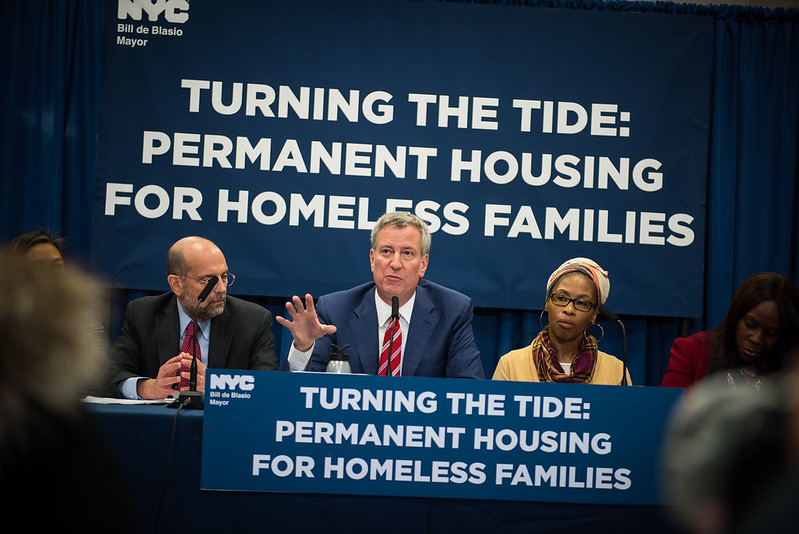
Mayor de Blasio addressing housing plans (photo: Edwin J. Torres/Mayoral Photography Office)
New York City’s recent refusal to stand up to wealthy Upper West Siders is just another instance in an unending pattern of failures on housing and homelessness.
The saga of the Lucerne is emblematic of the interplay between the powerful and the powerless in New York City. In an effort to combat the spread of COVID-19, the de Blasio administration (after fierce advocacy from the Homeless Can’t Stay Home campaign) moved thousands of unhoused people from crowded shelters where social distancing is impossible to unused hotel rooms—one such hotel being the Lucerne on the Upper West Side.
Just days after the Lucerne welcomed its new residents, a now-15,000 member private Facebook group called Upper West Siders for Safer Streets formed, calling for the unhoused men at the Lucerne to be removed from the neighborhood, referring to them as “scum'' and “trash.” At the same time, UWS Open Hearts Initiative, a coalition of Upper West Siders committed to “compassion in our backyard,” organized to support the men at the Lucerne.
While the emergency nature of the move created some difficulties on the front-end, the shelter provider swiftly addressed community concerns through increased staffing and on-site services. Organizations like UWS Open Hearts Initiative also stepped up to provide supplemental support and resources and serve as a model for shelter-community integration.
Nonetheless, Mayor Bill de Blasio caved to the monied voices of the Upper West Siders for Safer Streets, and now the men are slated to be moved from the Lucerne to a hotel in the Wall Street area.
The city’s failure to prioritize the wellbeing of the men at the Lucerne is not an isolated incident and represents a consistent lack of leadership on housing and homelessness. As of July 2020, 58,089 New Yorkers were sleeping in the city Department of Homeless Services-run shelters each night—a sizable increase from the 53,615 New Yorkers sleeping in such shelters when de Blasio took office in January 2014.
But, it’s important to remember that our homelessness crisis is fueled by our affordable housing crisis—they are intrinsically linked. The deference that the city has shown to exclusionary neighborhoods like the Upper West Side has greatly contributed to our affordable housing crisis.
The city itself conducted a study on Mayor de Blasio’s housing strategy that found that building affordable housing in wealthy neighborhoods like the Upper West Side could create more affordable units at a lower cost to the city. However, as the city’s affordable housing map shows, this advice went ignored.
When compared to Brooklyn Community Board 5 in East New York and Bronx Community Board 3 in the South Bronx, Manhattan Community Board 7 in the Upper West Side is an affordable housing desert. Below is a breakdown of the new affordable housing constructed since Mayor de Blasio took office in each of these areas:
Not only has the Upper West Side constructed far less new affordable housing than Brooklyn CB5 and Bronx CB3, but it has hardly created any new affordable housing for tenants of extremely low (30% of AMI) or very low (50% of AMI) income.
Furthermore, the bulk of newly-constructed affordable housing units on the Upper West Side are on its outskirts—the borders with Morningside Heights in the north and Hell’s Kitchen in the south. Only a single new affordable unit has been built in the heart of the Upper West Side, at 214 West 72nd Street.
In fact, data indicates that the Upper West Side isn’t just diametrically opposed to housing the men at the Lucerne, housing the homeless, or even affordable housing in general, but rather all new housing. Since 2010, the Upper West Side has actually lost housing—in the midst of an affordable housing crisis.
Rather than following its own advice and building affordable housing in neighborhoods like the Upper West Side, the de Blasio administration has deferred to the wealthy interests of those neighborhoods and maintained their status quo.
Neighborhoods like the Upper West Side have played a direct role in our city’s homelessness and housing crisis. It is time for them to take responsibility, and that starts with housing people experiencing homelessness in their neighborhood, and continues with building new affordable housing there too.
***
Michael Sutherland is a Research & Policy Associate at Housing Rights Initiative. On Twitter @msuthnyc & @housingrightsny.
***
Have an op-ed idea or submission for Gotham Gazette? Email This email address is being protected from spambots. You need JavaScript enabled to view it.
A Change New York Must Make to Protect Safety Net Providers and Their Clients
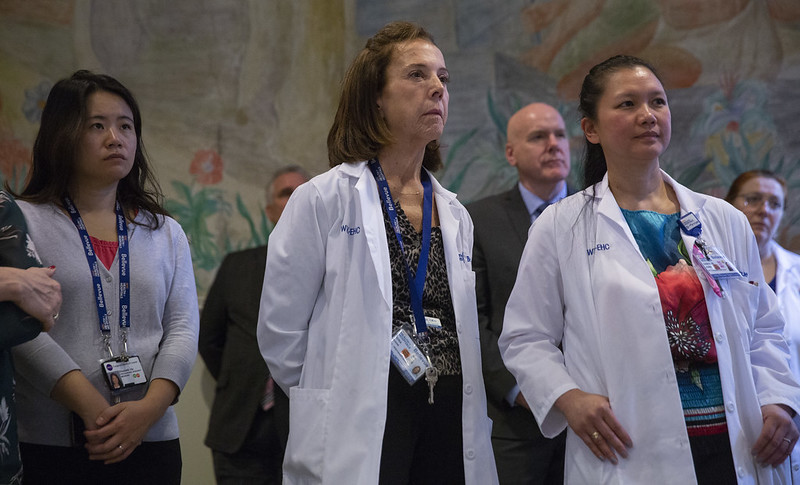
Health care professionals (photo: John McCarten/NY City Council)
Finalizing a budget can be chaotic in the best of times. This year, we hammered out the last details of the state’s $177 billion spending plan as the COVID-19 crisis was approaching its peak in New York State.
It was in this context that the Legislature agreed to a little-noticed recommendation from the Governor’s Medicaid Redesign Team II (MRT II) that strips a critical federal benefit from health-care providers and patients in New York. Luckily, we have until April 1, 2021 to undo this mistake. I will be working non-stop over the next seven months to do just that, along with a coalition of advocates and Medicaid patients as part of the Protect the Safety Net campaign.
The MRT II pushed through a provision in the budget that would “carve out” a pharmacy benefit from the state’s Medicaid managed-care program and shift payment to a fee-for-service reimbursement. The commission claimed its goal was to lower costs and increase transparency, but in reality this provision would devastate Ryan White Clinics, federally-qualified health centers, safety net hospitals, and other safety net providers in the 340B drug discount program. In Monroe County, for example, Trillium Health, Jordan Health, and the University of Rochester Medical Center all rely on 340B to provide essential services to families in our community.
The federal 340B Drug Discount Program protects safety net providers from drug price increases and gives them access to pharmaceuticals at discount prices. This includes HIV/AIDS clinics that receive support under the Ryan White CARE Act as well as community health centers that have been on the frontlines of fighting COVID-19. 340B providers rely on this funding to operate food pantries, provide transportation assistance, STI screenings, mental health and wellness programs, and run harm reduction programs – services that are often grossly underfunded by the state.
If the carveout is not reversed, many patients across New York State will simply have nowhere to turn. These are not savings that should be made on the backs of those who can ill afford these cuts.
The 340B Program is under constant threat from Big Pharma, which has tried to distort and undermine the program since it was established with broad, bipartisan support back in 1992. For the pharmaceutical industry, a discount program for Medicaid patients just means less profit. For short-sighted bureaucrats in Albany, it’s a chance for accounting gimmicks that allow them to claim “savings” that would actually harm the vulnerable New Yorkers they are supposed to be serving.
The Medicaid commission chose the worst possible time to experiment with changes to New York State’s safety net. 340B providers care for patients in communities that have been hardest hit by the COVID-19 pandemic. If these providers are forced to eliminate services, more patients will be forced to go to hospital emergency rooms for care – swamping our hospital system and driving up costs while leading to poor health outcomes.
This would also threaten the progress we’ve made in fighting the HIV/AIDS epidemic. Ryan White Clinics have built comprehensive models of health care and social services to address the diverse needs of their patients. This comprehensive model of care is only possible because of the clinics’ participation in the 340B program.
In the weeks and months ahead, New Yorkers will be hearing a lot more about this issue. The New York chapter of Ryan White Clinics for 340B Access recently launched a campaign to Protect the Safety Net, led by advocates and Medicaid patients. We’re going to keep fighting until the state reverses course and restores this critical benefit for the most vulnerable New Yorkers.
***
Assemblymember Harry Bronson represents Rochester and surrounding areas. On Twitter @HarryBBronson.
***
Have an op-ed idea or submission for Gotham Gazette? Email This email address is being protected from spambots. You need JavaScript enabled to view it.
How to Vote Biden-Harris and Protect Progressive Power in New York
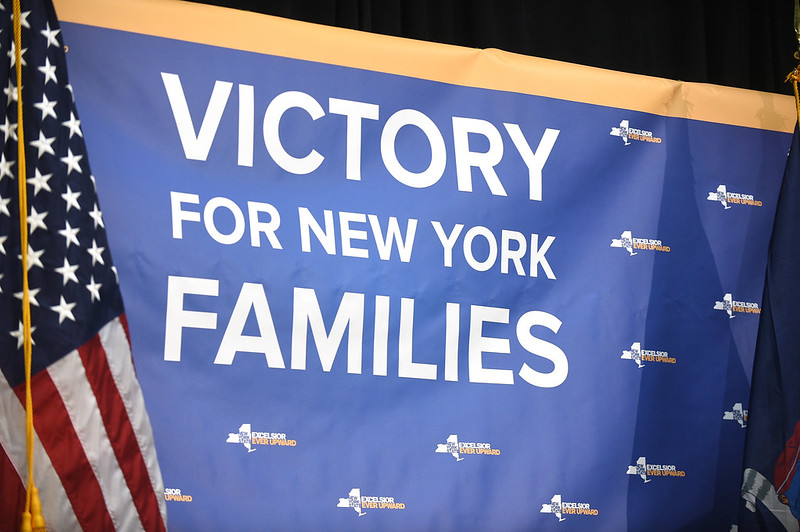
The Working Families Party's survival is on the ballot (photo: Kevin P. Coughlin/Governor's Office)
When we each ran for State Senate, the Democratic establishment supported our opponents — but the Working Families Party had our backs. That’s because for over 20 years, the WFP has stood up for working people’s champions running for the New York state Legislature and fought for true progressive power in Albany. So it’s no surprise that Governor Cuomo and the corporate Democratic establishment are now trying to take away the Working Families Party’s ballot line and weaken progressive power.
We can’t let that happen — that’s why we’re voting for Joe Biden and Kamala Harris on the Working Families Party ballot line, and you should too.
For decades, Albany was controlled by Republicans and corporate Democrats who worked hand in hand to empower themselves, rather than working people. The Working Families Party spent years campaigning to send working people’s champions to Albany — leaders like State Senator Gustavo Rivera in the Bronx, Assemblymember Yuh-Line Niou in Manhattan, and Assemblymember Diana Richardson in Brooklyn. And in a historic power shift in Albany in 2018, the WFP recruited, supported, and elected a slate of candidates who unseated the Independent Democratic Conference and their corporate allies — flipping the State Senate blue for the first time in eight years and kicking off the most progressive legislative session in New York history.
While establishment Democrats refused to endorse that slate of progressive champions — Jessica Ramos, Alessandra Biaggi, Robert Jackson, Rachel May, John Liu, Zellnor Myrie (and me, Julia Salazar) — the WFP was in the trenches. The WFP built campaign plans, recruited volunteers, and brought in the grassroots support and progressive muscle we needed to win.
Because of the Working Families Party, the State Senate was able to push through massive progressive wins in 2019 that had been bottlenecked by Republican control for years: from historic tenant protections and voter access laws to landmark climate legislation and driver’s licenses for undocumented immigrants. And that same year, the WFP invested heavily in Tiffany Cabán’s decarceral District Attorney campaign. This cycle, the WFP continued to back progressives like myself, Jabari Brisport, Marcela Mitaynes, Khaleel Anderson, and dozens more.
So it’s no surprise that Governor Cuomo and his corporate allies have been laser-focused on weakening the Working Families Party — the party that wrested control away from the Governor and his Republican allies and began to truly deliver for working people. During this year’s budget negotiations amid a pandemic, the Governor slipped in an eleventh-hour clause — requiring all political parties to meet the strictest ballot requirements in the nation to maintain their ballot line. Parties once needed 50,000 votes every four years to maintain their ballot line. Now, they need 130,000 votes or 2% of all votes — whichever is higher — at the top of the ticket and they need these votes every two years, starting now. The threshold and timing were clearly meant to hurt the WFP this year, during a presidential election with very high turnout.
It’s clearer than ever why we must work to protect the Working Families Party’s ballot line: if not for the WFP, Democrats might be still battling with Republicans for control of the statehouse. Instead, GOP legislators are dropping like flies, corporate Democrats are on the defensive, and the Left is building real power in Albany.
We will both be voting on the WFP line, because we cannot let Governor Cuomo and his fellow corporate Democrats weaken our progressive power in the middle of the political fight of our lives. New York is in the midst of a massive public health crisis, while suffering the effects of decades of austerity budgets and racist police brutality. We need to build working people’s power in Albany — and the WFP plays a key role in that fight.
Tens of thousands of our loved ones have died because of the state’s crumbling health-care system; millions are at risk of eviction; too many to count cannot afford to feed their families. Unemployment claims are climbing, and New York and Washington have left our undocumented brothers and sisters out to dry. If Governor Cuomo has his way, New York will continue cutting funding for hospitals, schools, and localities instead of asking the wealthy to pay more so we can all survive. We can’t afford a weakened Left right now. By voting for Biden and Harris as well as candidates like us on the WFP line, you can help protect the ballot line — and protect the multiracial, people-powered movement for justice that this moment demands.
For those of us who believe in a truly progressive agenda, voting for this year’s Democratic presidential ticket is not going to be easy; Biden and Harris are far from the working people’s champions that this moment deserves. But we also know that we can and must use our ballot to vote against Trump and to vote to strengthen progressive power in New York, by voting for Biden and Harris on the WFP line. To win, we need to keep progressive power growing in New York — so join us, and vote for Biden and Harris on the WFP line.
***
State Senator Julia Salazar represents parts of Brooklyn in the 18th District and is running for reelection. Jabari Brisport is the Democratic and WFP nominee for Brooklyn’s 25th State Senate District. On Twitter @JuliaCarmel__ & @JabariBrisport.
***
Have an op-ed idea or submission for Gotham Gazette? Email This email address is being protected from spambots. You need JavaScript enabled to view it.





